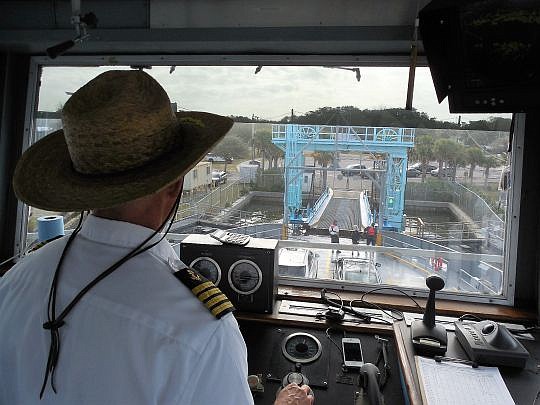
On the surface, so to speak, Chris Cavanaugh’s job as a St. Johns River ferry captain seems routine.
From the wheelhouse high above the vehicle and passenger deck, Cavanaugh guides the 168-by-64-foot Jean Ribault back and forth. And back and forth. And back and forth.
For seven hours, typically.
That’s 28 trips across the river between Mayport Village and Fort George Island.
Too monotonous? To the contrary.
“It’s a very good job. There’s not very many like it,” Cavanaugh said.
He’s right. There were 128 ferry operations in the country in 2014, according to the U.S. Department of Transportation’s Bureau of Transportation Statistics’ latest count.
Cavanaugh, 57, is nine years into his second career. His first was a 30-year U.S. Navy gig with 20 years at sea.
As he eyed retirement during his final assignment as an instructor at Mayport Naval Station, Cavanaugh made a checklist and started chipping away at it.
It took seven years to obtain the requisite high-grade mariner’s license. He couldn’t have planned his military-to-civilian transition any better.
“A lot of aviation folks do the same thing,” the upstate New York native said.
The morning shift for the captain, engineer, three deckhands and toll collector begins at 5:30 a.m. with a safety meeting.
“We talked about what we want to keep our eyes out for and handed out some assignments, including who was going to be in the rescue boat crew, in the event of an emergency,” Cavanaugh said.
Operated by the Jacksonville Transportation Authority, the Jean Ribault was docked for routine U.S. Coast Guard-mandated repairs from early January to early March.
Cavanaugh says he largely used the time to polish the ferry operation’s policies and procedures.
The service operates 6 a.m. to 8:30 p.m. every day of the year. The one-way fee for one of Northeast Florida’s best views is $6 for single-axle vehicles and $1 for pedestrians and bicyclists.
Wearing sunglasses, a white epaulet shirt and a wide-brimmed straw hat for protection from the relentless Florida sun, Cavanaugh’s clearly in charge.
Being accountable for the Jean Ribault’s crew and the lives of people crossing the river is a big responsibility.
“The current can be pretty strong and very unforgiving if you don’t handle it right,” he says, in a cadence slow for most Northerners.
Cavanaugh says he gets kidded for maneuvering the ferry like a grandmother. Slow and steady.
He considers it a huge compliment.
“Don’t ever go faster than you need to. That was instilled in me by Navy captains when I was driving ships in the open ocean and it stuck,” he said.
One of three full-time captains of the Jean Ribault, Cavanaugh fastidiously manipulates the two rudders and two throttles, guiding the vessel to a stop between the bulkheads.
“It’s a matter of balancing the power, keeping your momentum, working the angles,” he said. “If you slow down too much, it’s going to throw you around.”
The St. Johns River flows from south to north. When it rains nearby or south of Jacksonville, Mother Nature balances herself out by discharging the water up the river.
Combine that with tide shifts every six hours, the lunar cycle, Nor’easters and the area’s propensity for summer storms — and the captain’s job can get prickly. Four knots of current are equivalent to 69 mph of wind.
“Depending on whether the water’s coming or going determines how the captain needs to handle the boat,” Cavanaugh said. “It’s like stepping up onto an escalator and knowing there’s that little moment of uncertainty.”
Occasionally, he shuts the ferry down. There’s just too much at stake.
“I’d rather be known as the guy who didn’t go (through bad weather) than the guy who says I can make it and doesn’t,” Cavanaugh said.
But it’s calm sailing at the moment; the tide won’t fully change again for three hours.
“I don’t think I’ve hit the wall all morning,” he said. “But a captain is going to hit the wall. It’s how you recover and try to minimize the impact.”
He interrupts the interview.
“Stand by for loud whistle,” Cavanaugh said in an intercom before pressing a button. The old-time cry of a steam whistle reverberates.
The deckhands tie up the Jean Ribault, named for a Frenchman who sailed into the St. Johns River in 1562 to establish a refuge for French Huguenots, and motion for the motorists to drive away.
Then it’s time for a new assemblage of vehicles to come aboard for the five-minute, 850-yard haul to Mayport.
Some of the motorists are commuters; others choose the river passage along Florida A1A because there’s more scenery, and it’s often quicker than trekking along Interstate 95.
Vacationers Barry and Linda Hess opted for the ferry to avoid traffic as they traveled south to St. Augustine.
“It’s short, less than 15 minutes, but I can say that this is a highlight of our vacation,” said Barry Hess, of Monroe, Wis.
Eighteen years into her career as a deckhand, Debby Tretter says the ferry job is the best she’s ever had.
“It’s outside, where I like to be. And I like the people,” she said.
Cavanaugh doesn’t get to socialize with the passengers. But regulars know his voice.
“Thank you for riding the ferry. Stand by for a possible bump,” he announced.
The bump didn’t happen.
“I guess I’m having a good day,” he said. “But really, there aren’t many bad days out here.”